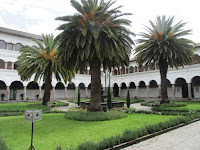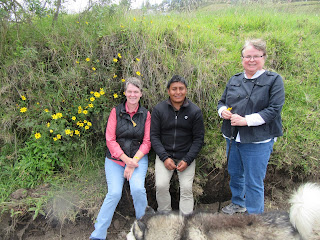
On Monday, January 30, 2017, we flew from MSP to Atlanta and thence to Quito, landing at Ecuador's capital city at about 11:20 p.m. By midnight we connected with Jorge, our English-speaking driver, who drove us the 45 minutes to La Casona de la Ronda, a heritage boutique hotel in the heart of old Quito. We were in bed and sound asleep by 2:00 a.m. Tuesday morning.
By 9:30 a.m., we were dressed and ready to go on a half-day tour of old Quito. Abby decided to stay behind because severely dry eyes the day before had left her tired and sensitive to light. Sarah, Mark, Beth, and I set off on foot with Natalia, our petite Quitena tour guide.
As luck would have it, we happened upon a parade of local school children honoring Antonio Jose de Sucre, a local hero of the war of independence against Spain. Sucre was the hero of the Battle of Pinchincha on May 24, 1822, which liberated Quito from the Spanish and led, eventually, to the founding of Ecuador.

The parade was led by high-school girls twirling batons that had black and white pom-poms attached to one end, followed by a drum major, a marching band, a float with foam cannons, and girls dressed in indigenous costumes doing indigenous dancing. The drum major and marching band members wore quasi-military uniforms, including helmets with horsehair plumes. The helmets and "horsehair" were made of plastic, but the effect was quite striking from a distance.
In colonial times, Quito was divided into four quarters, the
Augustinian, Dominican, Franciscan and Jesuit quarters. After the parade, we walked from the Plaza de San Domingo to
the monastery of San Augustino. The monastery surrounds a Spanish-style
courtyard with a fountain and palm trees in the center. Murals of the life of
the saint, exposed to outside air, but covered from rain, line the outer edge
of the loggia around the courtyard. The loggia ceiling is decorated in the
Moorish style with carved pine cones suspended from each rectangle in the
ceiling.

Natalia took us into the Chapter Room, where an Ecuadorian
declaration of independence was signed in 1809. The original table and one of
its chairs was still preserved inside the room. On the opposite wall was a
gilded crucifixion. Natalia explained that sheeps’ stomachs were used to polish
the skin of Christ to make it shine. The 1809 revolution was unsuccessful, and
all those who signed the document were later executed by the Spanish.
We walked to Independence Square, where the presidential
palace faces the square, across from city hall. On a third side of the square
is the building that houses the national assembly. A short Ecuadorian man in
his early sixties approached Natalia and asked what country we are from. When
she said “Los Estados Unidos,” he asked how we felt about Trump. Sarah gave the thumbs-down sign. The man smiled and walked off.
Our next stop would be the most
beautiful church in all of Latin America, according to our Insight guidebook of
Ecuador, the Church of the Company of Jesus (Jesuits). Although the façade is
unremarkable, carved andesite stone, the interior is magnificent. Gilt is
everywhere. The arched ceiling is made of brick that was covered with red – or dark
pink – plaster and then gilded. Then the gilt was selectively carved away to
reveal beautiful arabesque patterns. Unfortunately, photography was not
allowed, so I purchased some postcards so that Abby could see the interior.
Natalia pointed out the blue
ceiling inside the dome that imitates the sky, and the light coming in from
windows in the dome that evokes the sun. Frescoes of the four evangelists
circled the dome, each with his symbol, Mark with a lion, John with an eagle,
Luke with an ox and Matthew with an angel.
Running short on time, we
hot-footed it to the church of San Francisco, set higher on the slope of the
mountain. Just below the church is a gift shop advertising fair trade goods.
Earlier I had expressed interest in buying a Panama hat, misnamed because they
are actually made in Ecuador, so we stopped at the fair trade shop and I bought
a good one. Sarah found a white blouse with embroidery from northern Ecuador.
We took a quick peek inside the church and then headed for the statue of the
Virgin of Quito.

Known formally as the Virgen del
Panecillo, the statue has a height of 30 meters, set on a plinth of 11 meters.
Stairs inside allowed us to climb to the top of the plinth and walk around the
outside. We could see the aluminum alloy
plates that were first bolted onto a frame and then brazed together. The virgin
is portrayed as an angel with wings standing on a snake that she controls with
a chain around its neck. The virgin, as she subjugates evil, overlooks the city
of Quito.
For a late lunch we sat on a
rooftop patio of a restaurant not far from the hotel. We had a variety of
Ecuadorean fare, including empanadas, a tamale, chicken soup, shrimp ceviche,
roasted chicken with hominy, potato soup, and fried yucca. After a short rest,
we gathered in the hotel lobby for a bottle of Carmen Sauvignon Blanc from
Chile and a plate of cheese and crackers. Dinner was at a 6th-floor
restaurant a sort cab ride away with a great view of the city.
 This would be our last day in Ecuador and, since
our flight was not scheduled to leave until midnight, Alejandra decided that
our day would not start until noon. We were okay with that. We drove about an hour to the Hacienda
Sierra Alisos, in Tambillo in the foothills of the Ilinizas, a pair of volcanic
mountains. We passed a horseback rider on the way in, which made us feel like
we were in the Ecuadorian equivalent of cowboy country.
This would be our last day in Ecuador and, since
our flight was not scheduled to leave until midnight, Alejandra decided that
our day would not start until noon. We were okay with that. We drove about an hour to the Hacienda
Sierra Alisos, in Tambillo in the foothills of the Ilinizas, a pair of volcanic
mountains. We passed a horseback rider on the way in, which made us feel like
we were in the Ecuadorian equivalent of cowboy country.  After lunch in the hacienda, some
of us decided to ride bicycles, since the bike trails had been described as
"flat," or "plano" in Spanish. They were flat only in
comparison to the Andes Mountains. Most people ended up walking up to a pair of
adobe houses on a hill overlooking the main hacienda, which was also adobe.
Sarah and Mark, who have an adobe house in Tucson, were especially interested
in the Ecuador version of adobe architecture. One of the houses was rammed
earth rather than adobe, meaning it was made with forms rather than adobe
blocks.
After lunch in the hacienda, some
of us decided to ride bicycles, since the bike trails had been described as
"flat," or "plano" in Spanish. They were flat only in
comparison to the Andes Mountains. Most people ended up walking up to a pair of
adobe houses on a hill overlooking the main hacienda, which was also adobe.
Sarah and Mark, who have an adobe house in Tucson, were especially interested
in the Ecuador version of adobe architecture. One of the houses was rammed
earth rather than adobe, meaning it was made with forms rather than adobe
blocks.  We drove back into Quito for a
private cooking class at the Plaza Grande Hotel. We made seviche and ice cream,
the latter involving lots of dry ice. We ate a traditional Ecuadorean dinner of
meat, beans, corn and rice. The food was delicious. A man dressed in a strange purple costume,
looking disconcertingly like a purple Klansman, served us our dessert, smoking
from the dry ice used to cool it. On the way out, in the hotel lobby, we saw
men dressed in tuxedos and women dressed in gowns getting ready to go to a wedding at the nearby Jesuit
church. We said goodbye to Alejandra, and then Jorge drove us to the airport
for our uneventful flights home.
We drove back into Quito for a
private cooking class at the Plaza Grande Hotel. We made seviche and ice cream,
the latter involving lots of dry ice. We ate a traditional Ecuadorean dinner of
meat, beans, corn and rice. The food was delicious. A man dressed in a strange purple costume,
looking disconcertingly like a purple Klansman, served us our dessert, smoking
from the dry ice used to cool it. On the way out, in the hotel lobby, we saw
men dressed in tuxedos and women dressed in gowns getting ready to go to a wedding at the nearby Jesuit
church. We said goodbye to Alejandra, and then Jorge drove us to the airport
for our uneventful flights home. Despite the tribulations of this
trip - partial blindness, seasickness, altitude sickness, and the heat and
humidity on the Galapagos - we loved Ecuador. The people are friendly and the
climate in the mountains is perfect. Our stay with Selso and Sylvia's family in
the Magdalena indigenous community was very special. We resolved to spend the
next year improving our Spanish so that we could return next winter, spend some
more time with them and get to know them better.
Despite the tribulations of this
trip - partial blindness, seasickness, altitude sickness, and the heat and
humidity on the Galapagos - we loved Ecuador. The people are friendly and the
climate in the mountains is perfect. Our stay with Selso and Sylvia's family in
the Magdalena indigenous community was very special. We resolved to spend the
next year improving our Spanish so that we could return next winter, spend some
more time with them and get to know them better. 













































